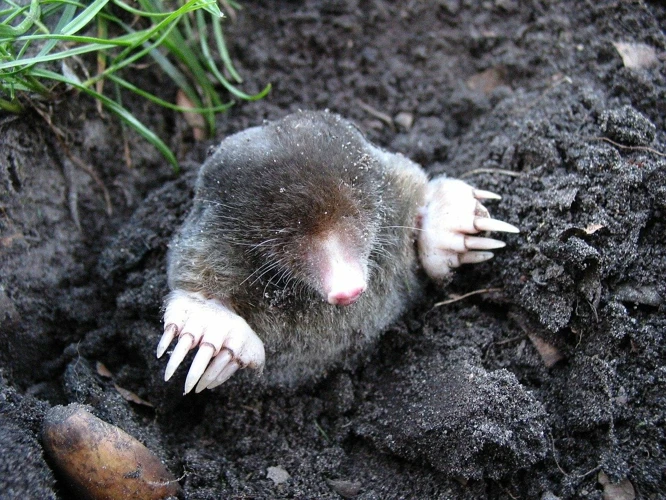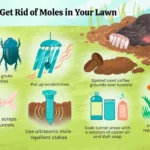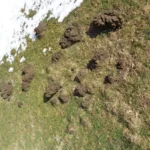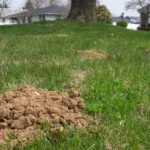Have you ever noticed strange tunnels and mounds in your garden or yard? Maybe you’ve even seen plants wilting or dying for no apparent reason. It’s possible that moles are the culprit. These elusive creatures might seem like a nuisance, but they actually play an important role in your garden’s ecosystem. Understanding the relationship between moles and plant growth is crucial for maintaining a healthy and thriving garden. In this article, we’ll take a deep dive into the basics of moles, their impact on plant roots, and how they benefit your plants. We’ll also explore the link between soil quality and mole activity, how to identify signs of mole damage, and methods for controlling mole damage in your garden. Let’s dig in!
The Basics of Moles and Plant Growth
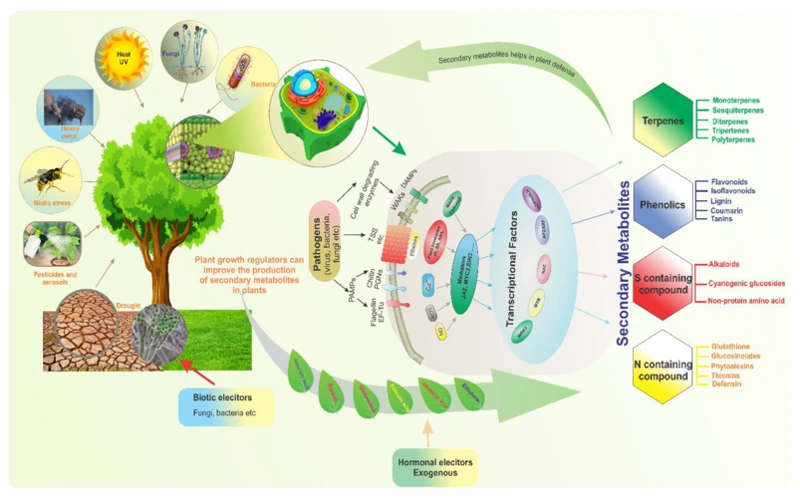
Understanding the relationship between moles and plant growth is crucial for any gardener or farmer. While these small mammals may often be considered pests due to the damage they can cause to lawns and gardens, they also play a vital role in soil health and plant nutrition. In this section, we will explore the basics of moles and their impact on plant growth, as well as the link between soil quality and mole activity. By the end of this section, you’ll have a better understanding of how moles can both harm and benefit your plants. For more information on identifying and preventing mole damage to plants and trees, check out our article on Identifying Mole Damage in Plants and Trees.
Moles 101
| Appearance | Moles are small, cylindrical mammals with dark, velvety fur that ranges from gray to black. |
| Habitat | Moles live in underground tunnels that they dig in search of food, primarily earthworms and insect larvae. |
| Reproduction | Female moles give birth to litters of 3-5 young each year, typically in the early spring. |
| Behavior | Mothers raise their young alone, while adult moles are solitary and territorial. They are most active at night and during the early morning and evening hours. |
| Impact | While moles are not harmful to humans or larger animals, they can cause significant damage to lawns, gardens, and agricultural crops by uprooting plants and creating tunnels. |
Understanding the basic characteristics of moles is essential in managing their impact on plant growth. When moles are allowed to dig underground tunnels freely, they can cause damage to plant roots and negatively impact soil quality. It is important to know about their behavior, habitat, and impact to determine the most effective methods for controlling mole damage. By controlling and preventing mole damage, plants and trees will be less vulnerable to root damage and the soil can maintain its health and nutrition.
The Impact of Moles on Plant Roots
Moles can have a significant impact on plant roots, which can ultimately affect the overall health and growth of your plants. The burrowing and tunneling activity of moles can cause damage to plant roots, making them more vulnerable to disease and pest infestations. In severe cases, the damage can even lead to plant death.
The impact of mole damage on plant roots includes:
- Root Exposure: As moles tunnel through the soil, they can uproot plants and expose their roots. This can damage the delicate root system and make them more susceptible to drying out, disease and pest infestations.
- Root Compression: In addition to uprooting plants, mole activity can also compress roots. This can impact nutrient and water uptake, hindering plant growth and reducing overall plant health.
- Root Destruction: Moles can also directly damage or destroy plant roots through their burrowing and tunneling activity, causing irreversible damage to the plant.
If left unchecked, mole damage to plant roots can have detrimental effects on your garden or lawn. However, by taking preventative measures and using effective mole control methods, you can protect your plants from damage and ensure their long-term health. For more information on preventing mole damage to plants and trees, check out this helpful resource: prevent-mole-damage-plants-trees.
How Moles Benefit Your Plants
Moles are often considered a pest by gardeners and homeowners, but they actually offer some benefits to your plants. Here are some ways that moles can actually benefit your plants:
| Benefit | Description |
|---|---|
| Control of Insects and Pests | Moles feed on insects and grubs that can damage the roots of your plants. By reducing the number of pests in your soil, moles can help protect your plants from damage. |
| Improved Soil Structure | As moles dig their tunnels, they aerate the soil and help break up compacted soil. This can improve soil structure and make it easier for plant roots to grow and absorb nutrients. |
| Increased Soil Nutrients | The tunnels created by moles can improve soil drainage and increase access to nutrients for plant roots. This can help your plants grow stronger and healthier. |
While moles may have some benefits for your plants, it’s important to monitor their activity to ensure that they don’t cause damage. If you notice signs of mole damage in your garden, such as damaged roots or plants, it may be time to implement mole control methods. Check out our article on combating mole damage to garden and orchard for tips on keeping moles under control.
The Link Between Soil Quality and Moles
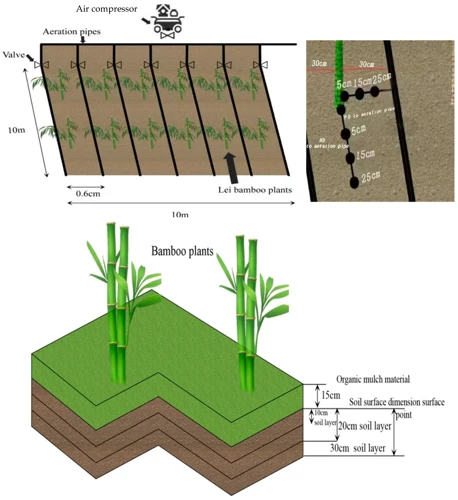
Moles are often seen as a nuisance to gardeners due to the damage they can cause to lawns and gardens. However, their impact on soil quality and plant growth is often overlooked. Understanding the link between moles and soil quality can provide insight into how your garden functions and can inform strategies for combating mole damage. In this section, we will explore the ways in which moles impact soil quality and how that, in turn, affects plant growth. We’ll also discuss signs of mole damage and strategies for controlling it. To learn more, check out how moles damage plant roots and impact tree health.
How Mole Tunnels Impact Soil Moisture
Moles may create an intricate network of tunnels beneath the soil surface that can significantly impact soil moisture. These tunnels can cause soil to dry out quickly, which can lead to plant dehydration and damage.
So how do mole tunnels affect soil moisture?
Moles create tunnels by digging deep into the soil to create a network of underground passages. These tunnels can effectively drain the soil of water by allowing the moisture to be lost through the sides of the tunnels. As a result, plants can struggle to receive the necessary amount of moisture from the soil, leaving them susceptible to damage and ultimately impacting their growth.
| Mole Tunnels and Soil Moisture | Effect on Plants |
|---|---|
| Mole tunnels drain moisture from soil | Plants can become dehydrated and damaged due to lack of necessary moisture |
If you notice that your plants are struggling to grow or are beginning to wilt, it may be useful to investigate whether moles are causing damage to the area. Thankfully, there are ways to combat mole damage to your garden and orchard.
One way to address the impact of mole tunnels on soil moisture is to improve soil quality. This can involve regularly amending soil with compost or other nutrient-rich material to help retain moisture in the soil. Additionally, reducing compaction can improve the soil’s ability to retain moisture, helping to counteract the drying effects of mole tunnels. By paying attention to soil quality, you can help ensure that your plants receive the necessary moisture to thrive.
Another common way to address mole damage is by controlling mole activity. While there are both non-lethal and lethal methods for controlling moles, it is important to consider the potential impact of each method on soil quality and overall plant health. One non-lethal way to deter moles is by using natural repellents, such as garlic or castor oil. Alternatively, if more severe mole damage has already occurred, lethal methods such as trapping or fumigation may be necessary.
By understanding how mole tunnels impact soil moisture, you can better assess the damage they may be causing to your plants and work towards effective control and prevention. For more information on the relationship between moles and plant health, check out our article on why plants and trees are vulnerable to mole damage.
The Role of Moles in Soil Aeration
Moles have long been recognized as a nuisance pest in gardens and lawns, but their impact on soil health is often overlooked. One of the key roles moles play in soil health is soil aeration, which refers to the process of air exchange between the soil and the atmosphere. This is vital for plant growth as roots need access to oxygen to function and grow properly.
Moles play an important role in soil aeration by burrowing through the soil and creating channels that allow oxygen to enter the soil. In fact, studies have shown that mole burrows can increase soil aeration by up to 70%. These tunnels also help to increase water infiltration and drainage, both of which are vital for healthy plant growth.
Table:
| Moles and Soil Aeration | Burrowing through the soil creates channels for oxygen to enter |
|---|---|
| Importance of Soil Aeration for Plants | Roots need access to oxygen to function and grow properly |
| Impact on Soil Aeration | Mole burrows can increase soil aeration by up to 70% |
| Secondary Benefits | Increases water infiltration and drainage |
It is important to note, however, that excessive mole activity can lead to soil compaction, which can have a negative impact on soil health and plant growth. This is because compacted soil has reduced pore space and therefore reduced air and water infiltration. It is important to balance the benefits of mole activity with the potential negative impacts, and take steps to control excessive mole activity if necessary.
Internal html link: To learn more about the impact of mole damage on plant roots and tree health, check out our guide on Moles Damage Plant Roots: Impact Tree Health. Additionally, if you are dealing with mole damage in your garden, our guide on Combating Mole Damage to Garden and Orchard offers helpful tips and tricks for controlling these pests.
How Soil Quality Affects Mole Activity
Soil quality is an essential factor in determining the activity of moles in your garden. The presence of nutrients and moisture in the soil is key to increasing the abundance of earthworms and grubs, making the soil more attractive to moles. This, in turn, leads to more mole activity in your garden.
On the other hand, deficient soil quality has the opposite effect. Soil with a lack of nutrients and moisture may not have enough food for earthworms and grubs to thrive, resulting in lesser mole activity.
Soil composition affects the ease of burrowing for moles. The texture of the soil plays a crucial role in mole activity, as they prefer loose soil. Sandy or loamy soil types are much easier for moles to tunnel through, as opposed to soils with high clay content. The presence of rocks and roots can also make burrowing more difficult for moles.
In addition, pH levels also play a role in soil quality and mole activity. acidic soil can make it more challenging for earthworms to live and burrow, therefore decreasing mole activity in the area. Conversely, soil that is slightly alkaline or neutral favors earthworm growth, thereby attracting moles.
Soil quality is a significant factor in the abundance of moles in your garden. By ensuring that your soil has the right levels of nutrients, moisture, pH and loose soil, you can encourage the presence of earthworms and grubs, which in turn increases mole activity. To learn more about how moles affect soil health, you can read our article on “Moels, Soil Health, and Plant Nutrition”.
Signs of Mole Damage in Your Garden

As a gardener, nothing is more frustrating than putting in hard work and effort to maintain your plant beds, only to discover that pesky moles have caused damage below the surface. Fortunately, there are several telltale signs that can help you identify whether you have a mole problem in your garden. From the distinct mounds of soil that they create to the damaged roots of your plants, recognizing these indicators early on can help you take proactive measures to prevent further destruction. In this section, we’ll delve into the various signs of mole damage, and explore how to effectively manage mole activity in your garden.
Identifying Mole Hills
Identifying Mole Hills can be a telltale sign of mole activity in your garden. These small mounds of soil can appear quickly and may be scattered throughout your lawn.
| Identification | Description |
|---|---|
| Size | Mole hills are generally small, conical mounds of soil that are usually less than 3 inches in diameter and height. |
| Location | Moles create their hills as they dig tunnels through the soil in search of food. Look for mole hills along areas of your lawn where the soil is relatively soft and moist, such as near garden beds, trees or shrubs. |
| Shape | Mole hills are generally circular or oval-shaped with a larger opening at the top of the cone. |
| Texture | The soil in a mole hill is often loosely packed, making it easy to distinguish from undisturbed soil in your garden. |
If you spot mole hills in your garden, it may be a sign that moles are damaging your plants and trees. It’s important to take action to control mole activity before they cause significant damage to your landscape. Learn more about repairing mole damage to your garden and landscape design, or discover effective repair techniques for plants and trees affected by mole damage.
Recognizing Mole Trails and Runways
One of the most noticeable signs of mole activity in your garden is the presence of mole trails and runways. These are essentially tunnels that the moles create as they move through the soil in search of food. To help you recognize these signs, here are some characteristics of mole trails and runways:
| Mole Trails | Mole Runways |
|---|---|
| – Visible tunnels just below the surface of the soil | – Visible tunnels that are deeper in the soil |
| – Often wind or curve around plants | – Straighter and more consistent in their direction |
| – May have raised ridges or mounds along their length | – Typically do not have raised ridges or mounds |
| – May be more visible after a rain, when the soil is wet | – Are often visible even when the soil is dry |
It’s important to note that mole trails and runways can sometimes be confused with the tunnels of other pests, such as voles or gophers. If you’re not sure whether the tunnels in your garden are the work of moles, you may want to consult with a pest control professional for assistance with identification.
Spotting Damaged Roots and Plants
One of the most obvious signs of mole damage in your garden is the presence of damaged roots and plants. Here are some ways to spot this type of damage:
- Wilting plants: If you notice a plant has suddenly started wilting, it could be a sign that its roots have been damaged by moles. Wilting is caused by a lack of water and nutrients, which can occur if a plant’s roots are severed or if they’re not getting enough water due to mole tunneling.
- Bare spots: If you see areas in your garden where there used to be plants but now there are just bare spots, it could be a sign that moles have been feeding on the roots of those plants. When moles feed on the roots, they can kill the plant, leaving nothing but bare soil behind.
- Dead or dying plants: If you have plants in your garden that are dead or dying for no apparent reason, mole damage could be the culprit. Again, moles can cause damage to roots which can ultimately kill the plant.
- Loose soil: If you notice that the soil around your plants is loose or has been pushed up, it could be a sign that moles have been tunneling around the area. This tunneling can cause soil erosion and can ultimately damage plant roots.
It’s important to note that not all damaged roots and plants are the result of mole activity, so it’s important to rule out other potential causes before taking action to control moles in your garden. Keep an eye out for other signs of mole activity, such as mole hills and trails, as well as other common garden pests that can cause similar damage to roots and plants.
Controlling Mole Damage in Your Garden
Dealing with mole damage in your garden can be a frustrating experience for any gardener. Moles can cause significant harm to your plants, so it’s important to take action to prevent further damage. There are a variety of control methods available, both lethal and non-lethal, each with their own advantages and drawbacks. In this section, we’ll explore some of the most effective ways to control mole damage and protect your garden from further harm. So, let’s dive in and find out how to deal with moles in your garden!
Non-Lethal Mole Control Methods
When it comes to controlling moles in your garden, there are several non-lethal methods you can try before resorting to more extreme measures. Here are some effective and humane ways to control mole activity:
- Mole repellents: Mole repellents are a popular option for keeping moles away from your garden. These products use natural ingredients like castor oil or garlic to create an unpleasant scent that moles find repulsive. Simply sprinkle the repellent around your garden and reapply as needed.
- Pinwheel windmills: Pinwheel windmills are a cheap and easy way to deter moles from your garden. The spinning motion of the pinwheels creates noise and vibration that moles dislike, causing them to move elsewhere.
- Mole netting: Mole netting is a physical barrier that can prevent moles from digging in your garden. Simply lay the netting over the affected area and secure it in place with stakes. Be sure to check the netting regularly to ensure it hasn’t been damaged or disturbed.
- Flooding: Flooding the mole tunnels with water is another non-lethal option for controlling mole activity. However, this method is only effective if your garden is located on a slope or if you have access to a high-pressure water source.
Remember to always use caution when dealing with moles in your garden. While these non-lethal methods are effective, they may not work for every situation. If you’re unsure about the best course of action, it’s always best to consult with a professional pest control expert.
Lethal Mole Control Methods
When it comes to controlling moles, some people may resort to lethal methods when all other options fail. However, it’s important to note that killing moles could potentially harm other beneficial wildlife and upset the natural balance of your garden ecosystem. If you do decide to use lethal mole control methods, here are a few options to consider:
- Poison Bait: Poison bait can be effective in killing moles, but it can also be harmful to other animals that may ingest it. Make sure to use it with caution and follow the instructions carefully to avoid accidental harm to other animals.
- Traps: Traps are a more humane option than poison bait, but they require regular checking to ensure that trapped moles are not left to suffer. There are two main types of mole traps: scissor-jawed traps and harpoon traps. Scissor-jawed traps work by crushing the mole’s head, while harpoon traps impale the mole. These traps should be placed in active mole tunnels for the best results.
- Fumigation: Fumigation involves pumping toxic gas into the mole tunnels to kill the moles. However, this method can be dangerous and should only be attempted by a professional pest control service.
Remember, lethal mole control methods should only be used as a last resort and with caution. It’s always best to try non-lethal methods first and to consider the impact on other wildlife before resorting to lethal solutions.
Preventing Future Mole Damage
Preventing future mole damage in your garden is an essential step you should take in order to ensure healthy plant growth. Here are some prevention methods you can apply:
| Method | Description |
| Proper lawn maintenance | Keeping your lawn properly maintained by mowing it often and removing any debris or weeds can help deter moles from setting up residence. Moles prefer to tunnel in thicker lawns, so keeping it neat and tidy can help. |
| Keeping soil healthy | Moles tend to feed on grubs and insects that live in unhealthy soil. By implementing healthy soil practices like adding organic matter, reducing chemical use, and reducing compaction, you can reduce the number of insects and grubs in your soil, making it less attractive to moles. |
| Use mole repellents | There are several repellents on the market that are designed to deter moles from inhabiting your lawn or garden. These repellents come in various forms, including granules, sprays, and electronic devices. |
| Install barriers | Barriers can be installed in areas where moles tend to frequent. Using hardwire mesh or landscape fabric can create a barrier to prevent moles from burrowing in a particular area. |
Taking preventative measures can help reduce the risk of future mole damage, allowing your plants to grow and thrive.
Conclusion
After delving into the topic of moles and plant growth, it is clear that these burrowing creatures have a complex relationship with gardens and lawns. While they can be destructive to plants and create unsightly mounds of dirt, they also play a crucial role in soil aeration and moisture retention.
On the one hand, mole tunnels can damage the roots of plants by upending them and disrupting the flow of nutrients. The soil disturbance caused by moles can also lead to the loss of topsoil and erosion.
On the other hand, moles offer numerous benefits to gardeners by loosening soil, leading to better drainage and nutrient uptake by plants. Their burrowing activities can also create air spaces in soil, allowing roots to grow more easily and improving the ability of the soil to hold water.
While mole damage can be frustrating to deal with, especially for those with manicured lawns, there are numerous non-lethal and lethal methods of control available. These range from traps and baits to natural remedies like castor oil and garlic. Additionally, maintaining healthy soil conditions can help deter mole activity in the first place.
All in all, understanding the relationship between moles and plant growth can help gardeners make informed decisions about how to manage these creatures. While it may be tempting to completely eradicate them, moles can actually be beneficial in moderation. By using targeted control methods and striving for healthy, well-aerated soil, gardeners can strike a balance between minimizing damage and embracing the benefits of these underground dwellers.
Frequently Asked Questions
How can I tell if moles are causing damage to my plants?
Look for raised tunnels or mounds of soil in your garden, as well as damage to the roots of your plants.
Do moles only eat plant roots?
No, moles primarily eat earthworms and other soil-dwelling insects, but they may accidentally damage plant roots while tunneling through soil.
How do moles benefit plants?
Moles help to aerate soil, improve soil moisture retention, and control pest populations by eating insects harmful to plants.
Can moles be harmful to my garden?
Yes, moles can damage plant roots and displace soil, which may lead to a weakened root system and poor plant growth.
What can I do to control mole damage in my garden?
You can try non-lethal methods such as installing physical barriers or using repellents, or lethal methods such as using poisons or snap traps. It’s important to research and choose a method that is safe and effective.
Are there any natural predators of moles?
Yes, some predators of moles include foxes, owls, and snakes.
Do different species of moles have different impacts on plant growth?
While different species of moles may have slightly different habits and diets, the impact of moles on plant growth is generally similar across species.
Can moles help to improve soil quality?
Yes, moles can help to improve soil quality by aerating the soil and increasing moisture retention. However, their impact on soil quality may also depend on other factors such as soil type and landscaping practices.
What should I do if I suspect a mole infestation in my garden?
Consult a professional for advice on the best course of action, and consider implementing both short-term and long-term mole control strategies to prevent future damage.
Is it safe to eat vegetables or fruits grown in soil with mole activity?
Yes, it’s generally safe to eat produce grown in soil with mole activity, as moles do not directly consume edible plants and their impact on soil quality can be beneficial. However, it’s important to properly wash all produce before eating to remove any potential contaminants.

